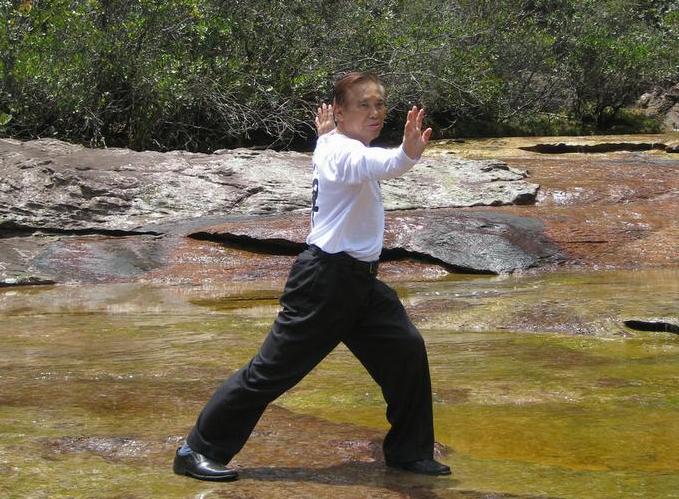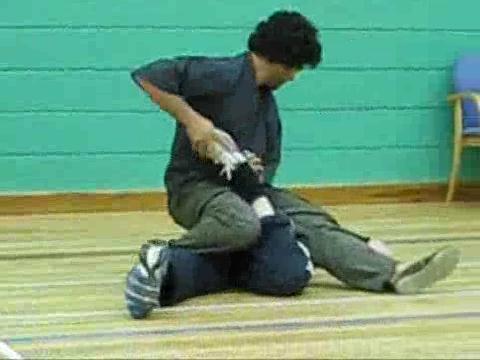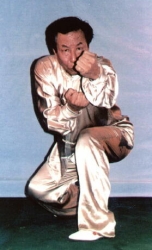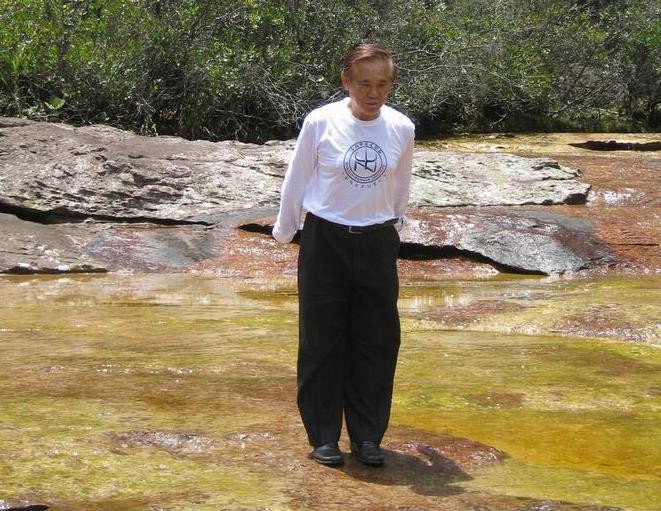SELECTION OF QUESTIONS AND ANSWERS
JULY 2012 PART 3

Grandmaster Wong Kiew Kit demonstrating a pattern from the Eighteen-Lohan Art
Question 1
I just wanted to thank you again for the wonderful Summer Camp in Brighton (2011). I have been practising the 18-Lohan Art almost every day, and I have had remarkable benefits to my health and vitality.
— Omar, England
Answer
The Eighteen-Lohan Art is a wonderful set of chi kung exercises. It is almost lost now. We are very fortunate to be able to preserve it. Due to its long historhy, there are at present a few different versions of the Eighteen-Lohan Art.
Question 2
I can feel that although I have a complex and deep blockage, perhaps originating from before my birth, I am making rapid progress and I feel it being pushed slowly outwards from my depths. It is a wonderful feeling, like ice slowly melting into a flowing river of joy after a long winter. The 18 Arts seems to me to be a very good balance between 'force' and 'flow' and the range of exercises seems to work every part of my system in a holistic and complementary way. It is truly a wondrous set of exercises!
Answer
Yes, the Eighteen-Lohan Art is very effective for clearing deep-rooted blockage.
Your imagery of ice slowly melting into a flowing river of joy after a long winter is beautiful and excellent. I also like your apt description that the Eighteen-Lohan Art has a good balance between "force" and "flow".

Omar applying a pattern, "Reverse Riding of Donkey", from the Drunken Eight Immortals on an opponent
Question 3
I have also been greatly enjoying the Drunken Eight Immortals Set.
We also had the great pleasure of learning Chinese Chess from Siheng Chun Yian. It was literally a mind expanding experience. I have had many subtle benefits from this course.
Answer
Your siheng, Anthony Spinicchia, has described it as the most complete kungfu set. It has everything -- striking, kicking, felling, chin-na and floor work. Perhaps it lacks a special section for force training, like that found in the Triple-Stretch and the Flower-Set. But for us, the whole Drunken Eight Immortals Set can be used for force training.
By itself Chinese chess is an interesting game with good opportunities to execise our mind. It was even more rewarding when Chun Yian taught the class how to apply strategies in playing Chieese chess to enrich our daily life.
Question 4
I have been thinking about some of the things you said at the Summer Camp about the Muslim masters at the Shaolin Temple. As a Muslim I find this fascinating. I have tried to find out more about these past masters in our lineage, but unfortunately I did not find anything on the Internet. Do you know where I can find out more? Do you know any of the names of the great Muslim masters of the Shaolin Temple and anything about their lives? I would be very grateful for any further information.
Answer
I do not know the names of Muslim masters in the Shaolin Temple itself, because at the Shaolin Temple one's religion was not mentioned. I believed there could be many but their religion was not made known. Nevertheless, I know of many Shaolin masters who were Muslims. The following are some examples.
Chaquan, a widely practiced beautiful Northen Shaolin style, was named after its founder Cha Mi Er, which is the Chinese pronunciation of the Muslim name Jamil.
The famous modern Chaquan master, Wang Zi Ping, was a Muslim. He convincingly defeated many masters from many countries who came to China to test the combat effectiveness of kungfu.
The founder of Bajiquan, Wu Zhong who lived in the 18th century, was also a Muslim
Admiral Cheng He of the Ming Dynasty, who led the largest naval fleet known in history to as far as the Americas, was a famous Muslim.
Another Muslim master who practiced Shaolin Kungfu was Ma Xue Li who lived in the 18th century. He practiced Xinyi-Liuhequan, or Mind-Intention-Six-Harmony Kungfu, and was a disciple of the Xingyiquan patriarch, Ji Long Feng.
Amongst the famous styles of Shaolin Kungfu, Chaquan, Bajiquan and Xinyi-Liuhequan are widely practiced by Muslims.
Two famous Muslim masters in China today are Ma Dian Da and Zhao Chang Jun.
Ma Xian Da, a Bajiquan master, won the first kungfu free sparring competition organized by the present Chinese government in 1952, beating other traditional masters. He was the author of many kungfu and wushu books, and edited the Chinese Wushu Encyclopaedia. Although he was a famous wushu coach, he laments that wushu practitioners cannot fight, and criticizes sanda as devoir of wushu features.
Zhao Chang Jun was the national wushu champion of China for 10 consecutive years from 1978 to 1987. Yet, he strongly advocates for traditional kungfu, being a Tantui master himself.

Sifu Ma Xian Da. Picture reproduced from http://www.taichi-wushu.com.au/pages/GMMaXianDaView.aspx
Question 5
There is a saying (hadith) of the Prophet Mohammed, "Seek ye knowledge, even unto China". I feel personally that I have had the great blessing of fulfilling this commandment through Shaolin Wahnam. For this I am deeply grateful to God, yourself, the past masters and my brothers and sisters in our school.
Answer
I am happy that we have many Muslims in our school. Many Muslim masters consider that the training of energy and mind, called "qi" and "shen" in Chinese, and known as "nafas" and "roh" or the "breath" and "spirit" of God in Muslim terminology, are essential for the highest spiritual cultivation. This is exactly what we do in Shaolin Wahnam.
Question 6
Why do we massage our face after a chi kung session?
— Wendy, USA
Answer
There are three good reasons why we perform the facial massage, the point massage the heavenly drums as well as walking about after a chi kung session.
The massaging and heavenly drums act as a transition from the cosmic dimension we are in during chi kung practice to the everyday conditions of our daily life. If one does not perform this transitional art, he may find himself in a cultural shock when he opens his eyes after deep chi kung practice.
Secondly, massaging the eyes and face, and walking about to spread energy all over the body give us rosy cheeks, sparkling eyes and enable our energy to nourish our internal organs.
Thirdly, all these help in what we call the normalization process. Immediately after a chi kung session we feel special. We feel we are more powerful, and the world looks more beautiful. After the massaging and walking about, we feel normal. We may feel as if we have less energy than immediately after the chi kung session.
But, has energy been drained away? No, in fact energy has been put into good use. The extra energy derived from the session flows into our body to nourish our internal organs, making them stronger and healthier than before. But the increase of strength and health is so gradual that we may not notice it on a day-to-day basis. But if we compare to the time before we started our chi kung practice, we can feel a lot of differences.
This is the process of normalization. We do not want to feel healthy and strong only after a chi kung session. We want to be healthy and strong all the time. In other words, being strong and healthy is nothing special, it is our norm as a result of practicing chi kung.

When practiced correctly, "Reverse Hanging of Double Hooks" demonstrated here by Grandmaster Wong Kiew Kit, can produce tremendous internal force
Question 7
Why does Reverse Hanging of Double Hooks produce so much internal force?
— Sifu Jeffrey Segal, Chief Instructor of Shaolin Wahnam Australia
Answer
When we hook our hands backward and lean forward from our ankles, we consolidate a lot of energy at our arms and legs. When we return to upright position and relax totally, we set free a tremendous flow of energy from our arms and legs.
This sets the three hand yin meridians flowing down the arms, pushing up the three hand yang meridians which flow up the head and chest, and link with the three leg yang meridians.
Meanwhile, the three leg yang meridians, which have been consolidated earlier due to leaning forward at the ankles, flow down the legs vigorously, pushing the three leg yin meridians up the legs and into the body to link with the three hand yin meridians. This activates the phenomenal big universal chi flow.
As we are relaxed, when the big universal chi flow is activated, not only the flow comes from energy that is inside our body, but Cosmic energy also flows into our body to enhance the big universal chi flow. This results in a tremendous amount of internal force.
Question 8
In the training of One-Finger Shooting Zen, is it necessary to regulate the breathing for every movement?
Answer
No, it is not necessary. For example, suppose we perform 10 repetitions in the "flow" stage of our training. Initially we may regulate our breathing for the first 5 or 6 repetitions. When we have activated the flow and it is flowing spontaneously on its own, we need not regulate our breathing.
Later, when the flow is smooth, out of 10 repetitions we only need to regular the breath about 2 or 3 times, and these 2 or 3 times need not be consecutive. For example, the first time we regulate the breath it may be at the 2nd repetition, and the second time we regulate the breath it may be at the 6th repetition.
Eventually it may not be necessary to regulate the breath at all. Just a thought will activate the chi flow accordingly.
The same procedure applies to visualization. Initially we may gently visualize chi flowing from our back to our index finger as we breath out and move our One-Finger Zen out. We gently visualize chi flow from the Cosmos into ourselves as we breathe in and move our One-Finger Zen back. We gently visualize in this way for the first 5 or 6 repetitions.
When chi is flowing smoothly and correctly, we need to visualize 2 or 3 times anywhere out of 10 repetitions. Then eventually we need not visualize at all. This is "first visualization, then realization", a tern actually coined by you in the early Taijiquan days.
First we regulate our breath and visualize accordingly. Eventually when we have realizes the flow, we need not regular the breathing or visualize. Whether we should cease regulating the breathing first or the visualization, or vice versa, is not important.
LINKS
Selected Reading
- Glimpses of the Drunken Eight Immotals
- Songs of Secrets
- Satori and Solitude in Silent Standing
- Can Cancer be Cured?
- Marital Duties and Kungfu Training
